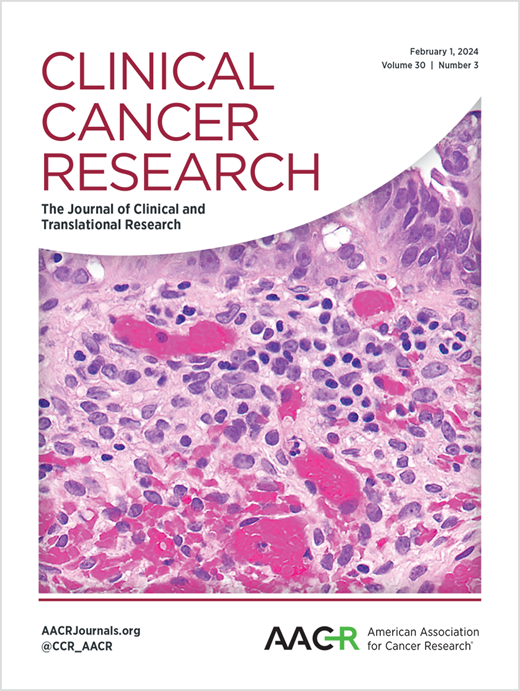Radiogenomic profiling of prostate tumors prior to external beam radiotherapy converges on a transcriptomic signature of TGF-β activity driving tumor recurrence
IF 10.2
1区 医学
Q1 ONCOLOGY
引用次数: 0
Abstract
Purpose: Clinical risk grouping based on PSA, tumor grade, and disease extent guides treatment intensity for localized prostate cancer. However, many patients with intermediate- or high-risk disease treated with external beam radiotherapy (EBRT) and androgen deprivation therapy (ADT) still develop biochemical recurrence (BCR). Early identification of patients at high risk for BCR could enable personalized treatment strategies. Experimental Design: We prospectively enrolled 29 patients with intermediate- or high-risk prostate cancer undergoing EBRT and ADT. Pretreatment biopsies (n=60) underwent whole-transcriptome microarray and whole-exome sequencing. Patients received multiparametric MRI (mpMRI) at baseline and 6 months post-treatment, with median follow-up of 6 years. Gene expression differences between patients with and without BCR were analyzed using pathway tools and validated in external datasets. A novel TGF-β gene signature was derived and tested across multiple cohorts (median follow-up: 5–11 years). Results: TGF-β activity was significantly associated with BCR in the discovery cohort (P = 0.0081), and correlated with PTEN/TP53 alterations (P = 0.0246) and baseline mpMRI tumor volume (P = 0.026). TGF-β activity also predicted metastasis-free survival (P = 0.037), and in an independent cohort (n=265) was prognostic for BCR-free (P = 0.05), metastasis-free (P < 0.001), and overall survival (P < 0.001). Conclusions: TGF-β activity is a dominant feature of intermediate-to-unfavorable risk prostate tumors prone to biochemical failure after EBRT with ADT and may serve as an independent prognostic biomarker beyond existing clinical criteria.前列腺肿瘤在体外放射治疗前的放射基因组谱分析集中于TGF-β活性驱动肿瘤复发的转录组学特征
目的:根据PSA、肿瘤分级、病变程度进行临床风险分组,指导局限性前列腺癌的治疗力度。然而,许多接受外束放疗(EBRT)和雄激素剥夺治疗(ADT)的中高危疾病患者仍会发生生化复发(BCR)。早期识别BCR高风险患者可以实现个性化的治疗策略。实验设计:我们前瞻性地招募了29例接受EBRT和ADT治疗的中高危前列腺癌患者。预处理活检(n=60)进行了全转录组微阵列和全外显子组测序。患者在基线和治疗后6个月接受多参数MRI (mpMRI)检查,中位随访6年。使用途径工具分析BCR患者和非BCR患者之间的基因表达差异,并在外部数据集中进行验证。一种新的TGF-β基因标记得到并在多个队列中进行了测试(中位随访:5-11年)。结果:发现队列中TGF-β活性与BCR显著相关(P = 0.0081),与PTEN/TP53改变(P = 0.0246)和基线mpMRI肿瘤体积相关(P = 0.026)。TGF-β活性也能预测无转移生存期(P = 0.037),在一个独立队列(n=265)中,TGF-β活性能预测无bcr (P = 0.05)、无转移(P < 0.001)和总生存期(P < 0.001)。结论:TGF-β活性是EBRT联合ADT后易发生生化衰竭的中度至不良风险前列腺肿瘤的主要特征,可能是一种超越现有临床标准的独立预后生物标志物。
本文章由计算机程序翻译,如有差异,请以英文原文为准。
求助全文
约1分钟内获得全文
求助全文
来源期刊

Clinical Cancer Research
医学-肿瘤学
CiteScore
20.10
自引率
1.70%
发文量
1207
审稿时长
2.1 months
期刊介绍:
Clinical Cancer Research is a journal focusing on groundbreaking research in cancer, specifically in the areas where the laboratory and the clinic intersect. Our primary interest lies in clinical trials that investigate novel treatments, accompanied by research on pharmacology, molecular alterations, and biomarkers that can predict response or resistance to these treatments. Furthermore, we prioritize laboratory and animal studies that explore new drugs and targeted agents with the potential to advance to clinical trials. We also encourage research on targetable mechanisms of cancer development, progression, and metastasis.
 求助内容:
求助内容: 应助结果提醒方式:
应助结果提醒方式:


